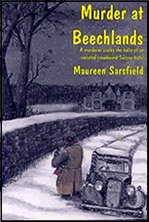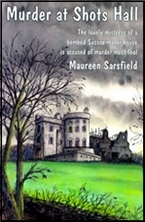Sat 29 Jan 2022
You may be forgiven if you have never heard of this author, She doesn’t get a mention (as far as I’m aware) in any of the critical works, though of course her three books are listed in Hubin.

My own interest in her books was inspired by a word of praise which she received in a bookseller’s catalogue. I located her earlier book without too much trouble, but her second mystery novel proved far more elusive. The third book listed by Hubin (Gloriana, Nicholson, 1946) is not a mystery so that for the purposes of this essay she falls to
be judged on her other two books only.
GREEN DECEMBER FILLS THE GRAVEYARD (Pilot Press 1945; Coward, 1946). The book is set in and around Shots Hall, the modest country home of Flikka Ashley and her Aunt Bee. The life of the small village community in which they live is disrupted by a series of fatal poisonings and all the evidence seems to point to Flikka.
Obnoxious Sergeant Arnoldson is all set to hammer it home but thankfully he is superseded by Inspector Lane Parry of Scotland Yard. Parry, the most civil and humane of policemen, gradually unearths the clues that point to the real murderer and the book ends happily and romantically.
The characters, major and minor, are all well observed: sharp tongued Aunt Bee, uncertain Dr. Abbot, odious Arnoldson, batty Miss Merridew, cunning old gardener Harry, and the rest. The narrative and dialogue are also particularly good, and the unravelling at the end caused no dissatisfaction at all. In short, a gem of a book and a real find.

DINNER FOR NONE (Nicholson. & Watson, 1948 and, as A PARTY FOR LAWTY, Coward, 1948). Lane Parry again and this time faced with that classical situation — a murderer, loose in a hotel cut off in all senses from the· outside world by heavy snow.
Unfortunately. the book does not work as well as its predecessor and creaks a little at times. I found myself getting rather muddled with the characters and situations, which all goes to show that this particular classical form is not as easy to deal with as Christie makes it seem.
The problem apparently lies with the confined quarters in which the puppet master has to make his puppets work. Nevertheless, Sarsfield’s book has many of the strong points that her first mystery had: good characterization, crisp dialogue, recognisable people (in most cases) and a neat tidy up at the end. Well worth searching out.
Alas, I cannot finish this with a biographical sketch I can pass on to you. I have seen not so much as a blurb that I can pass on to you, and Miss or Mrs. Sarsfield seems to have disappeared in 1948 as unobtrusively as she had arrived.
EDITORIAL UPDATE: The good news to readers of traditional good British detective stories from the 1940s (which of course you may already be full aware) is that both books were later reprinted by Rue Morgue Press, both in 2003. The first as Murder at Beechlands , and the second as Murder at Shots Hall.
It is also now known that Maureen Sarsfield was the pen name of pseudonym of Maureen Pretyman, (1899-1961). I suspect that the introductory material in both reprints have more to say about her.
January 29th, 2022 at 10:36 pm
Interesting sounding books. I hope they prove relatively easy to find still in reprint form.
It’s always surprising how many good mysteries are published that didn’t quite get the attention they might have deserved, and how many of those reprinted and rediscovered.
January 29th, 2022 at 11:08 pm
If you go looking, you needn’t pay much for either one. If you’re not fussy about condition, I’ll bet you can get both for less than $15 total.
The original hardcovers are another matter, but then again, not over the roof.
My review of book two is here:
https://mysteryfile.com/blog/?p=55636
While one by Bill Deeck is here:
https://mysteryfile.com/blog/?p=21067
January 30th, 2022 at 9:07 am
I was able to find more than one copy of this over the years after Bob recommended it. Of course, I didn’t read it, but… .
January 30th, 2022 at 1:54 pm
I’ve found a used copy of the first book, though a little pricey. There were cheaper ones, but I got badly burned on a “used, condition: good†recently, which arrived looking as if it had been on the floor of the angry child section of some old, tired library for a couple years…
Many thanks for this post, Steve!
January 30th, 2022 at 10:42 pm
“Shots Hall” and “Beechlands” are both available at Open Library.
https://openlibrary.org/authors/OL2235342A/Maureen_Sarsfield
January 30th, 2022 at 11:27 pm
Thanks, Shay!